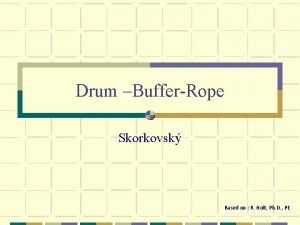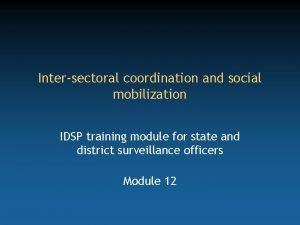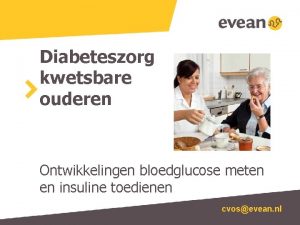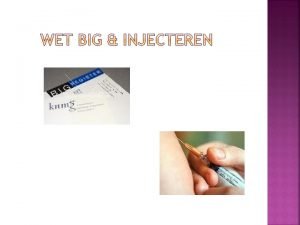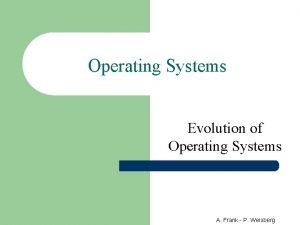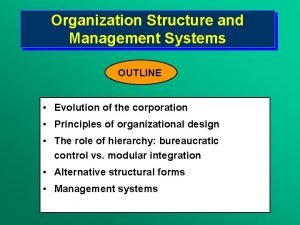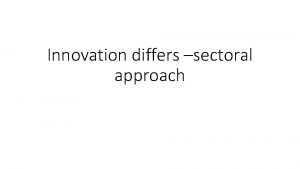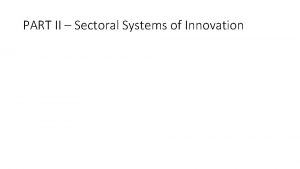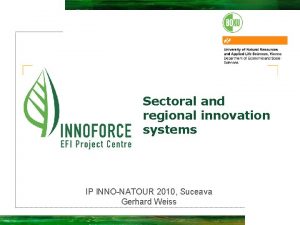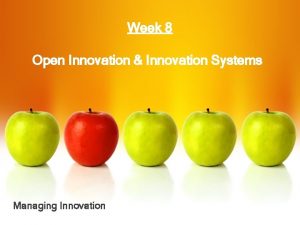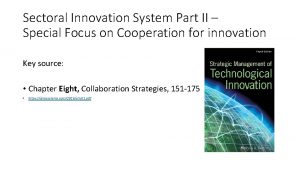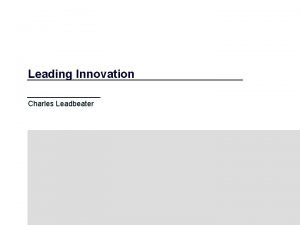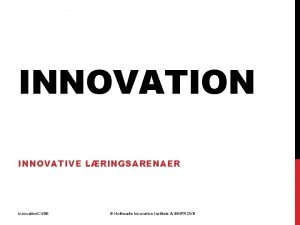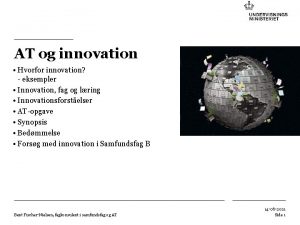WIP The evolution of sectoral innovation systems in



















- Slides: 19

WIP - The evolution of sectoral innovation systems in the Argentine & South African automotive manufacturing industries Michael Gastrow Education, Science and Skills Development Research Programme Human Sciences Research Council

Why compare innovation systems in the automotive sector Argentina and South Africa? • Context: SA-Argentina S&T Bilateral • Structural similarities • Historical similarities • No previous work on comparative innovation systems analysis between the two countries

Key areas of research for a comparative case study • Economic history and technological trajectories: how did the South African and Argentine automotive sectors respond to rapid globalisation, and how has this shaped their current systems of innovation? • How did firms respond to the challenges of exposure to global markets? • How did the policy environment impact on innovation? • What was the role of MNCs? • How did changing sourcing agreements, ownership, and investment impact on technological upgrading and innovation, including: systems of technology transfer & distribution, international knowledge and technology flows, sources of technology, domestic R&D patterns, expenditure on innovation, collaboration, etc • What are the lessons for policy-makers?

The evolution of innovation and technological upgrading the SA automotive sector • Origins of the SA automotive industry: 1920’s to 1970’s • 1976 – 1994: international isolation • 1994: re-inclusion in the global economy • So government developed the MIDP • Market liberalisation placed huge pressures on the industry, particularly on components suppliers • Turnover and employment losses in the mid and late nineties • Also major restructuring and competitiveness improvements in the sector: benchmarking, capital investment, technological upgrading, knowledge flows from MNCs, etc • And increased integration into global value chains…

Transfer of assembler ownership The result? Need to meet more stringent international demands Changes in sourcing agreements MNC-driven technology transfer and innovation

Integration into global value chains and changing sourcing agreements • Global sourcing agreements tied OEMs to MNC component manufacturers. Prompted many MNCs to move to SA, setting up greenfield operations or JVs • Shift in the ownership profile of the components supply base: sourcing of local technologies declined from 26% of supply base to only 10% • This squeezed SA technology and SA R&D from the automotive industry. Seems set for a long-term decline: fits in with pattern in the developing world in general. • But also fostered a complex of interactions between the 2 sets of technologies, skills & capacities. • Both positive and negative effects for domestic R&D • However, there have been other forces operating on R&D in the sector, incl. changes in production, trade and investment…

Production, trade and investment

• Key drivers: domestic economic growth, importation of skills from multinationals, improved competitiveness through benchmarking and upgrading, increased political security • Effects on technologucal upgrading and R&D? Increased investment in engineering, increased investment in local R&D may have acted as partial countermeasure to adverse value chain dynamics. 2008/9: Crash • Full data still required • Loss of jobs, production, investment. Pressure on R&D. • Government ‘bail-outs’ a short-term solution • Yet technological upgrading and innovation remain key to competitiveness in the long term.

SA Assembler capital expenditure: • • • Increasing success of the industry, incentives of the MIDP, improved domestic political and economic situation, drew increasingly large investments, particularly by OEMs Between 2001 and 2006 over 19 b Rand was invested, of which 2 b was towards R&D and Engineering fixed investment This supports the notion that growth in the sector (manifested in increased investment) supported auto R&D and allowed it to survive despite adverse value chain dynamics and other challenges R&D/ Engineering Total 1997 112 1266 1998 139 1343 1999 115 1511 2000 141 1562 2001 245 2078 2002 262 2726 2003 194 2325 2004 274 2220 2005 259 3576 2006 399 6215 2007 435 5753

Expenditure on R&D

OEM interviews • GMSA: • R&D capacity had eroded in previous years, but most of it had been retained. Main causes: high costs & lack of engineers. However, GMSA was the Design Centre for several models in the Africa/Middle East/Latin America markets. • R&D activities included heat & endurance testing, engineering for other GM models, development of specific components • New R&D tax incentive may spur increased R&D activity • VWSA: • Adaptive engineering on several models • Was lead product developer for Citi Golf – all R&D took place locally • Other R&D activities: product adaption to meet EU requirements, local content testing, engineering innovation towards cost reduction.

• DCSA: Adaptive engineering and components testing; software development • BMW SA: Minimal R&D activity; R&D strictly controlled by international body • Ford SA: ‘Lead Vehicle Engineer’ for several models. Included all design, testing, adaptation, modification, prototypes & crash tests. Further specialised research at dedicated R&D centre • Overall findings: Interviews identified the key areas in SA auto R&D: • Those OEMs designated as lead engineers performed a high level of R&D • Older models that remained in production generated a consistent demand for R&D • Other important niches include hot weather testing, component testing, and adaptation to local conditions • Key restraint identified by every respondent was a lack of engineers

Innovation and technological upgrading the Argentine automotive sector • 1960’s and early 1970’s: the sector grew under highly protected markets • Technological learning through the import of capital equipment, technical information, and patents. • Local product adaptation activity • Positive externalities for the industrial development of the whole economy • However, the high level of protection and lack of exposure to world markets allowed space for inefficiency (high model range, batch manufacturing, long lead times, low quality, etc) • Late 1970’s: • Contraction in the economy, trade balance and currency crises • MNCs exited the country or initiated mergers (incl GM, Citroen, Fiat, Peugot) • Stagnation eventually led to a policy change in policy favouring open markets and elimination of local content requirements. However, this opening did not go far enough, and the market was still relatively protected.

• 1980’s: • Continued protectionism lead to a limited uptake of WCM, a decade of contraction (average of 7%), and technological stagnation. • Policy makers recognised the necessity of further trade liberalisation, and embarked on a plan to re-orientate the sector towards exports. • 1988: The ‘Argentine Automotive Regime’ and a commercial partnership with Brazil • So the 1990’s were an era of exposure to global markets and production and technical restructuring that set the scene for growth that lasted until 2008 • The Argentina Automobile Regime: • • Incomes policy: reduced taxes on assemblers, reduced contribution to social security, set longterm wages • Industrial policy: a commitment by assemblers to investment, technological upgrading, and specialisation (fewer models) • Trade policy: import-export complementation scheme where assemblers obliged to export to the value of their imports. Commercial partnership with Brazil: • • And the role of MERCOSUR to US & EU MNCs investment strategies Led to structural changes in the 1990’s >

• Changes in MNC strategies and sourcing arrangements • Change in ownership and control • Increased integration into global production networks • Increased imports • Mixed success in moving towards WCM • TNCs imported technologies • • Changes in technological learning: • Mixed uptake of technologies from abroad, depending on ownership and market focus • Pockets of excellence • Little indigenous R&D – largely firms trying to import and adapt knowledge from outside the country And changes in the supply base: • Components sector also characterised by MNC-led sourcing and technological upgrading, accompanied by FDI and JVs • But many components firms struggled to adapt and remained stuck in Fordist systems • Challenge for components manufacturers as world prices set the benchmark • Re-structuring of the supply chain in favour of fewer, more competitive 1 st tier firms • Many local firms react to this challenge by orientating towards the ‘grey’ or afternarket.

• Technological upgrading and favourable market conditions led to sustained growth throughout the 1990’s: • Vehicle production increased from 100 k units in 1990 to 450 k in 1997 • Driven by exports: 1% of production in 1990 to 47% in 1997 • 2000 - 2007: • Continued export-driven growth • Accelerated MNC-driven technological upgrading • Further move towards WCM and integration into global supply chains • Brazil remained major trade partner • 2001 macroeconomic crises set back progress substantially, but recovery after the 2002 devaluation was fairly rapid • 2008 – 2010: Global financial crises – still calculating the fallout…

WIP Conclusions • Striking similarities between the opening up of these sectors in the 1990 s in SA and Argentina • Market liberalisation backed by policy support for vulnerable sectors led to short term difficulties for some, but long term success for the sector as a whole • Technological upgrading driven by: • MNCs importing technology through FDI and JV, largely through investment in engineering and R&D • Pressure on local supply base to reach WCM standards or fall out • Growth through export • Those firms that successfully adapted and upgraded technologically were set to reap the benefits of the growth period from the late 1990’s until 2007. • Skills, technology and innovation are keys to surviving the current crisis in the medium to long term in both South African and Argentina and it is here that the comparative case study can make a difference.

The way forward… • Obtaining R&D data from Argentina • Interviews with Argentine manufacturers • Combine with economic history to develop a more comprehensive analysis and comparison • Further comparisons of the effects of the MIDP and the Argentine Automobile Regime on upgrading and R&D to extract policy lessons • Exploration of the effects of the financial crisis…

WIP – the evolution of sectoral innovation systems in the Argentine & South African Automotive Manufacturing Industries Michael Gastrow Centre for Science, Technology and Innovation Indicators Human Sciences Research Council
 Wip buffer systems
Wip buffer systems Sectoral training
Sectoral training Intra sectoral coordination
Intra sectoral coordination Blueprint for sectoral cooperation on skills
Blueprint for sectoral cooperation on skills Wip example
Wip example Process costing and hybrid product-costing systems
Process costing and hybrid product-costing systems Insulin icodec
Insulin icodec Wip richtlijnen injecteren
Wip richtlijnen injecteren Innovation for the sake of innovation
Innovation for the sake of innovation Incremental innovation vs disruptive innovation
Incremental innovation vs disruptive innovation Evolution of operating systems
Evolution of operating systems Operating system evolution
Operating system evolution Evolution of embedded systems
Evolution of embedded systems Evolution of healthcare information systems
Evolution of healthcare information systems General motors organizational structure
General motors organizational structure Hát kết hợp bộ gõ cơ thể
Hát kết hợp bộ gõ cơ thể Ng-html
Ng-html Bổ thể
Bổ thể Tỉ lệ cơ thể trẻ em
Tỉ lệ cơ thể trẻ em Voi kéo gỗ như thế nào
Voi kéo gỗ như thế nào
